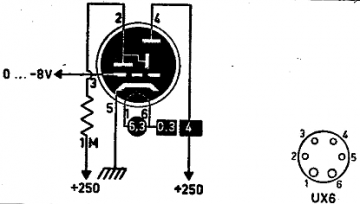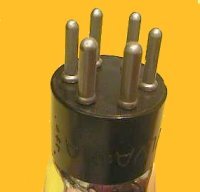
6E5
|
Variantes
|
|||||||||||||||||||||||||||||||||
|
Vus: 4933 Répondre: 1
6E5 (6E5)
|
|
|
Alessio Castagnini
11.Nov.11 |
1
Hello, is possible change a 6E5 with a 6E5C ? Please, let me know! Thanks a lot! Bye |
|
Michael Watterson
11.Nov.11 |
2
The normal 6E5 is 6 pin base and "bulb" shape. The 6E5C is straight sided and octal base.
So if you change the tube socket or there is space for an octal to 6 pin adaptor (by moving the existing base which usually isn't on the chassis), then yes it should work. The pattern is the same and the sensitivity should be similar. |
|
Vus: 5012 Répondre: 0
6E5 (6E5)
|
|
|
Robert Sarbell † 22.3.22
21.Mar.05 |
1
Gentlemen, There is a reference to the Sylvania tube number 6E5 associated with the photo in tube id=2111. I respectfully and totally agree that in my Sylvania News Technical Section Vol. 6 No. 1, is the complete article with photograph of the NEW tube as it was introduced by Sylvania (in the United States) in January 1936. With all due respect, I have no knowledge as to when the USSR would have introduced their first "visible tuning indicator". The original Sylvania tube used the ST-12 shaped bulb with the small 6-pin base - as illustrated in the present tube id. The pinouts are identical to those of the Sylvania. I have recently completed two (2) adapter sockets which now allow me to test the "rimlock" tubes, and the european F8, G8, and Y8 base. I am presently conducting tests with an adapter I have created which will permit testing the European sidepin octal tubes (DIN 41565) on the Hickok 752A tester. I have discovered there are some limitations with current draw to properly test some of the full-wave rectifiers. Respectfully, Robert |
Fin des contributions forum pour ce composant
| Mentions légales | Plus d'informations |






